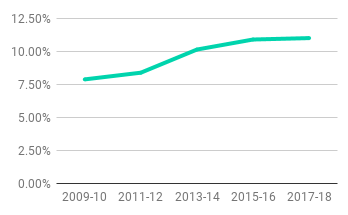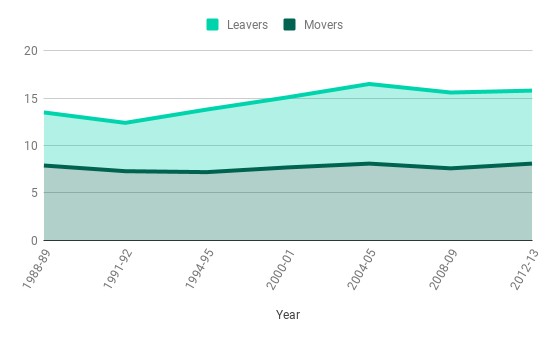This month we kicked off a year-long blog series on the topic of teacher retention. In this first post, we begin by summarizing the data that’s available on the problem of teacher turnover and evidence on the negative impacts of this turnover.
Earlier this month, the Professional Education Standards and Licensing Board (PELSB) released the latest Bi-annual Minnesota Teacher Supply and Demand Report. The report showed there were 63,692 teachers working in Minnesota’s public schools during the 2017-18 school year. The total number of licensed teachers was just over double that, at 133,945 teachers. In other words, less than half of Minnesota’s licensed teachers are currently teaching in public schools.
There are many reasons for this: some are teachers in independent schools (estimated at more than 5,000 teachers, the vast majority of which are licensed teachers but not included in the 63,696 number above); others have moved into administrative positions; and some have retired but still have a few years left on their license.
The fact remains, however, that a large number of teachers have left the job. In fact, the same report shows that 7,000 teachers, or about 11 percent, left their school or the teaching profession before the 2017-18 school year. And this number has risen over the last decade.

Figure 1. Percentage of Minnesota teachers who left their school district or charter school prior to the start of a given school year, as reported on Bi-annual Minnesota Teacher Supply and Demand reports. Note: this percentage does not include those who moved schools within a district.
Part of a national problem
National data on teacher retention paints a similar picture. The richest and most often cited data comes from the National Center on Education Statistics’ periodic survey of teachers and schools.
The survey, which also includes a follow-up questionnaire to capture responses from teachers who have left the profession, showed that for 2012-13 (the last year data is available), approximately 8 percent of teachers left their school (“movers”) and 8 percent left the profession (“leavers”). While the leaver rate has risen from 5.8 percent the first time the survey was given in in 1988-99, the rate has been relatively steady, nationally, over the last decade.

Figure 2. Percent of teachers nationally who left the profession or moved schools in a given year.
Another alarming trend in recent years is the asymmetry in which schools and teachers experience high turnover. Teachers in high-poverty schools and teachers who identify as teachers of color are more likely to leave their schools and the profession—and that discrepancy is growing. We will take up this topic more explicitly in future posts in this series.

While in absolute terms the problem of teacher turnover looks bleak, others assert it’s better to consider the problem in relative terms. They argue that, compared with other professionals—such as those in healthcare, construction, and IT—teachers actually have consistent or even modestly lower turnover rates. On the flip side, others point to the large comparative difference in attrition among American teachers (8 percent, as described above) vs teachers in other high-performing nations such as Finland, Canada, and Singapore (as low as 3 to 4 percent).
Ultimately, however, we argue that debating the extent of the turnover problem in relative terms is mostly unhelpful. As we describe in the following section, turnover has indisputably negative impacts on numerous elements of learning. Practitioners and policymakers should see addressing turnover as a high priority, regardless of its scale relative to other professions or other nations.
Why turnover matters
There are a number of reasons hypothesized, studied, and voiced by teachers as to why turnover has detrimental effects, including:
1. It inhibits learning. There is strong evidence that turnover is linked with low student achievement, and that the link is even stronger in schools serving large populations of students who experience poverty and students of color. Most mechanisms hypothesized for this observation come back to relationships and culture. Specifically, when teachers leave:
- Their relationships with students—which help to motivate students, adapt learning to their unique needs, and hold them to high expectations—are lost;
- The culture of collaboration and trust among staff is destabilized as social capital among colleagues must be rebuilt; and
- Knowledge about school strategies, initiatives, and programs, including which ones do (and don’t) work for their school community, is lost.
2. It contributes to shortages. On a more macro level, teachers leaving contributes to systemic shortages, especially given that teachers of groups underrepresented are more likely than average to leave, including math teachers, science teachers, special education teachers, and teachers of color. Put in economic terms, teacher turnover compounds undersupply—a reality which hits rural areas particularly hard.
3. It’s expensive. Replacing a teacher comes with numerous costs for a school, including hiring and onboarding expenses, coaching time, professional development courses, and more. Some estimates show replacement costs of $20,000 or more per teacher—money that could otherwise go to resources and offerings for students.
4. It signals other problems. Finally, high turnover matters because it often signals toxic conditions in the workplaces that teachers leave behind. High-stress school communities harm not only the physical and mental health of teachers—but also the students they serve.
So, why do teachers leave?
In sum, teacher turnover is substantial—both in its magnitude, and in its negative effects. The next logical question that arises is: why do teachers leave? Understanding the answers to that question is paramount to addressing solutions; the next post in our series takes up this critical question.
Found this useful? Sign up to receive Education Evolving blog posts by email.
We are grateful to the McKnight Foundation for their generous financial support for this series.
